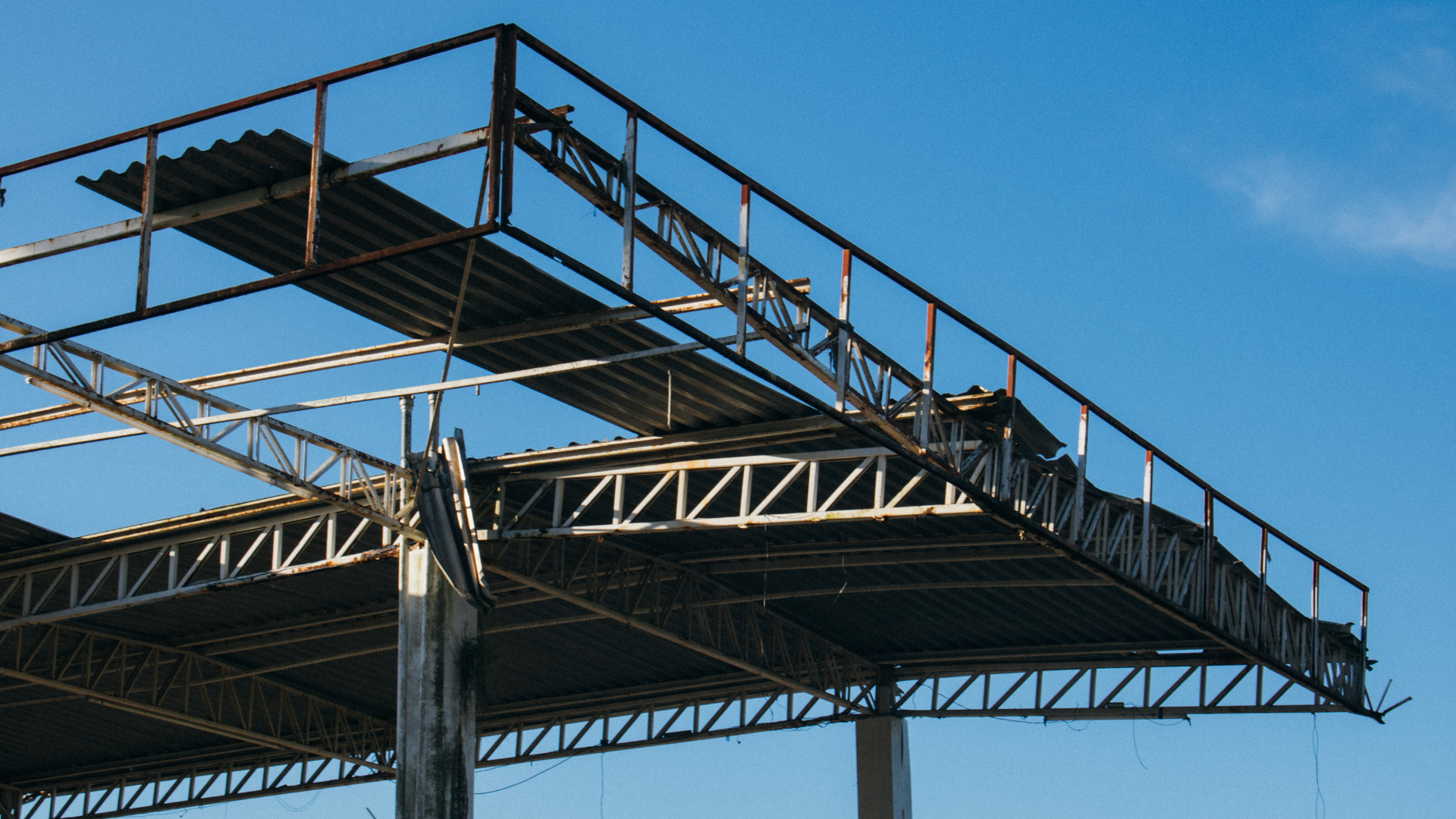July 15, 2025
Audio overview: Listen & Learn
Ever thought: What are the secrets behind the growth of top roofing companies? What are they doing differently, having better crews, better weather, or just better luck?
Well, it’s none of that. They’re just using the right data. Smart, simple, and real-time data!
While you’re busy chasing leads, overseeing crews, and hoping your marketing dollars aren’t wasted, they let data guide their next move.
And here's the best part: you don’t need to be a tech expert or hire an expensive analyst to achieve this. With the right tools and some smart habits, you can turn regular roofing tasks into drivers of growth.
Ready to learn how to leverage data to scale faster, cut through the clutter, and boost profits, all without feeling overwhelmed by charts or jargon? Let's find out what your data-driven roofing growth involves!
Data-Driven Roofing Growth: Using Data to Accelerate Roofing Business
The roofing industry’s best-kept secret: Data! Today’s growing roofing companies utilize data to identify what works, eliminate what doesn’t, and increase profits without doubling the workload.
That’s exactly where roofing software can really help make things easier and more efficient. It turns every lead, job, and crew into clear, actionable insights. The software knows, and it shows.
Even better? It automates tasks like scheduling, invoicing, and reporting, so you can focus on strategy instead of spreadsheets. Use it right, and your growth won’t just be fast... it’ll be unstoppable.
Key Takeaways
- Without tracking numbers, you’re merely hoping for the best without knowing what’s working, what’s wasting money, or what needs improvement.
- Roofing metrics for growth include job profitability, cost per lead, sales pipeline, sales performance, customer metrics, and performance metrics for marketing and the website.
- Leading roofing companies utilize data to boost revenue, grow efficiently, focus on high-ROI marketing and top-notch crews, and address bottlenecks to prevent delays and customer frustration.
- Advanced software, such as Rooferbase, enables you to effortlessly monitor job performance and sales metrics, providing data-driven insights to help you expand your business.
What Exactly Is Data-Driven Roofing Growth? And Why It Works
Data-driven roofing growth means leveraging the numbers already flowing through your business, such as lead conversions, job times, and profit margins, to make wiser and faster decisions.
In a nutshell: Simply facts, no guesswork involved.
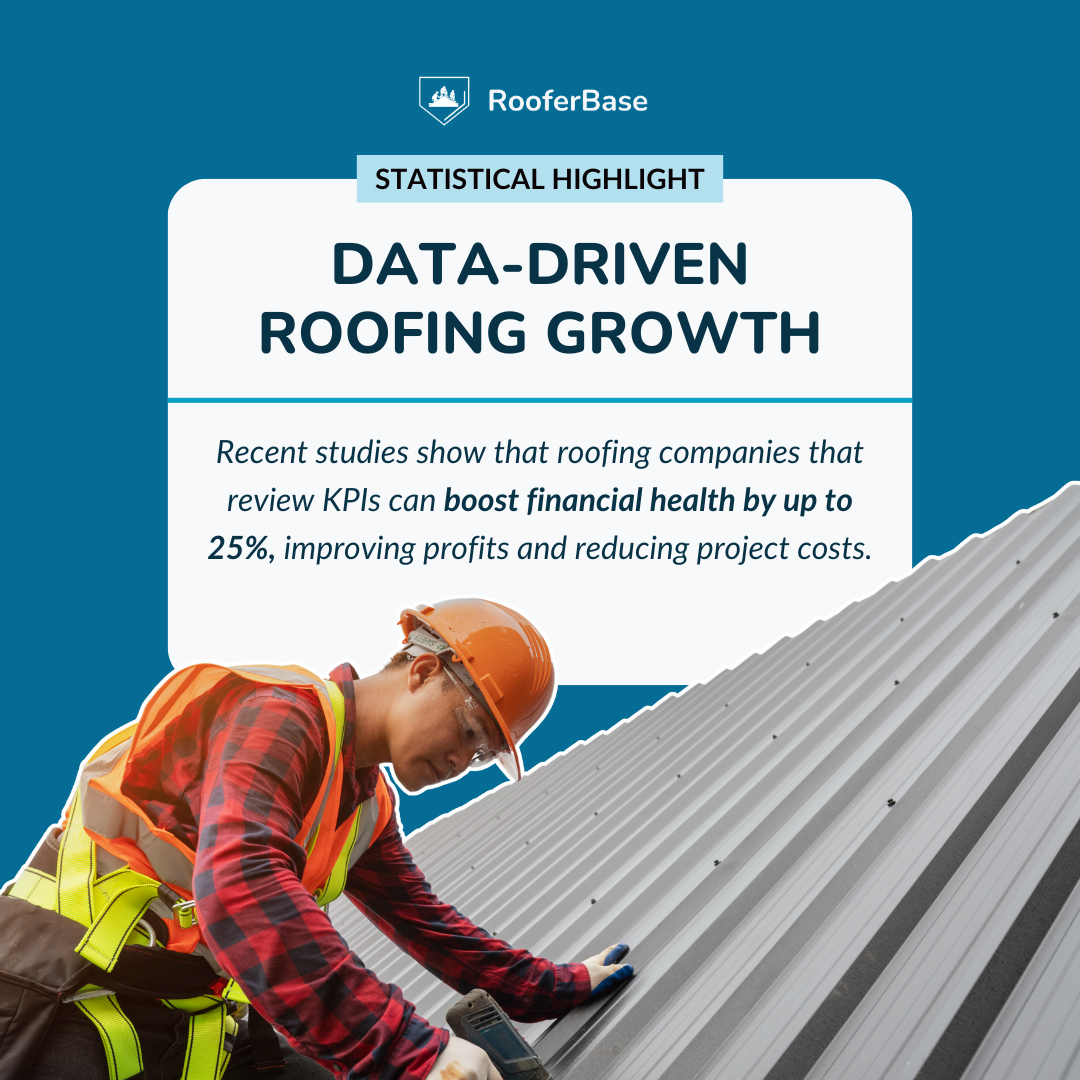
Statistical Highlight:
Recent studies show that roofing companies that consistently review their KPIs can improve their financial health by as much as 25%, leading to better profit margins and cost savings per project.
> Why manual guesswork is outdated in today’s roofing industry
Earlier, relying on memory, spreadsheets, or intuition to finish tasks was the norm. However, in the modern roofing industry, guesswork is comparable to climbing a ladder
while competitors utilize drones. It’s slower, outdated, and more dangerous.
When you’re not tracking numbers, you’re just hoping for the best without understanding what’s effective, what’s wasting money, or what needs fixing.
And that’s a risky way to run a business that involves: real crews, real customers, and real cash flow.
> How data puts you in control of time, money, and decisions
Data isn't just about numbers; it gives you clarity.
Imagine knowing exactly which ad generated the most leads or which crew completes jobs two hours faster with fewer callbacks. Using data, you shift from reacting to strategizing.
This helps you save hours, increase profits, improve productivity, and actually run your business instead of it running you.
> 3 Reasons Roofing Leaders Are Turning to Data
- Scalability: Data shows you what’s working so you can focus more on it and eliminate what’s holding you back.
- Predictability: You can use past data to forecast slow seasons, high-demand zones, and identify which products are likely to be in short supply.
- Profitability: Data helps you track job costs precisely and compare crew performance. This leads to more accurate estimates, higher margins, and clearer budgets.
So, how do you do it better?
The Most Important Roofing Metrics to Track for Growth
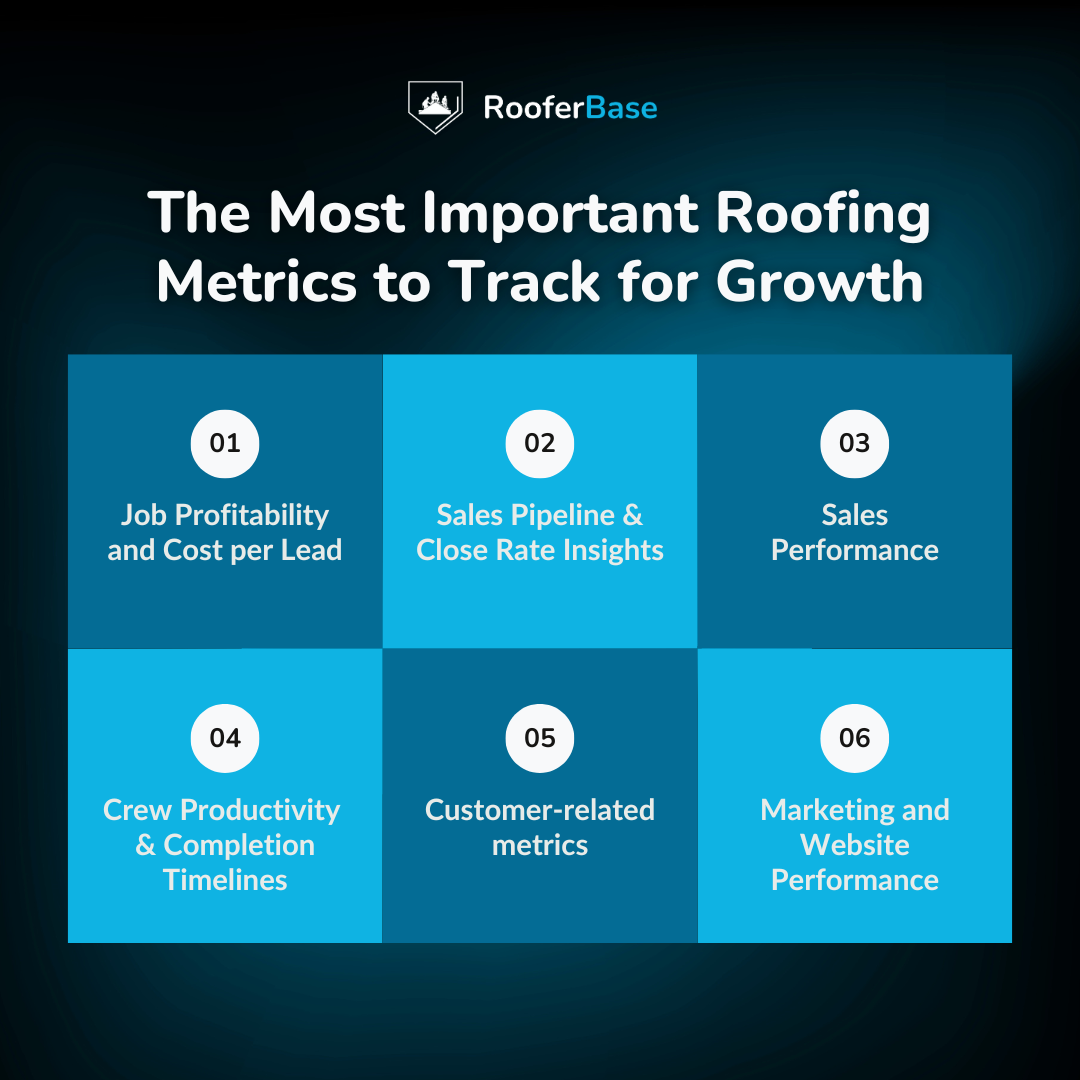
Here are the 6 roofing metrics you need to monitor closely if you want to grow faster, spend smarter, and scale confidently.
1. Job Profitability and Cost per Lead
Let’s get straight to the point: if you’re not earning money on each job, you’re putting in effort for nothing.
Let's understand better with the help of simple calculations:
For example, if your roofing business makes $100,000 in revenue and has $60,000 in total expenses.
| Metrics | What are their functions? | Formula | Calculations |
|---|---|---|---|
| Gross Margin | Shows your profit after deducting direct job costs such as labor and materials. | (Revenue - Direct Costs) / Revenue × 100 | Direct Costs = $50,000 Gross Margin = ($100,000 – $50,000) / $100,000 × 100 = 50% |
| Operating Margin | Considers profit after operating costs, prior to taxes and interest. | (Operating income / Total revenue) x 100 | Operating Income = $60,000 Operating Margin = (60,000 ÷ 100,000) × 100 = 60% |
| Net Profit Margin | Shows what is left after subtracting all expenses (taxes, interest, etc.). | (Total Profit after all expenses / Revenue) × 100 | Net Profit = $100,000 – $60,000 = $40,000 Net Profit Margin = ($40,000 / $100,000) × 100 = 40% |
> Don’t Forget Cost per Lead (CPL)
It’s not only about the number of leads you generate but also about the cost of each lead. The cost-per-lead metric helps you to track the effectiveness of your marketing spend.
Formula: (Total Marketing Spend ÷ Number of Leads)
Example: You spent $5,000 on ads and received 100 leads. CPL = $50. If you’re spending $50 to get a lead and only closing a few, that's a red flag.
Track both CPL and your margins together to scale more effectively.
2. Sales Pipeline and Close Rate Insights
Imagine adding 100 leads to your pipeline but only 10 convert, leading to a 10% close rate. This suggests a major leak in your funnel.
This is where data truly works:
- Track drop-off points: Where do prospects lose interest?
- Improve follow-ups: Use automation to reconnect with cold leads.
- Speed up the cycle: The quicker you finalize the deal, the sooner you can start.
3. Sales Performance:
Don’t just monitor who speaks the most; track who seals the most deals.
Key metrics:
- Monthly Close Rate by Rep: Measures the percentage of opportunities a sales representative successfully closes within a given month.
- Number of Leads Handled: Tracks how many leads a sales representative interacts with within a given timeframe.
- Revenue Generated Per Rep: This metric measures total revenue per sales rep during a period, indicating their financial contribution and ability to close high-value deals.
4. Crew Productivity and Completion Timelines
Do you know the team that consistently completes work ahead of schedule and rarely requires callbacks? Yeah, they’re excellent. How can they help?
Your roofing software can track:
- Average time to complete jobs per crew
- Jobs completed on time vs. delayed
- Work orders reopened because of poor workmanship
Example:
- Crew A: Average job = 3 days
- Crew B: Average job = 5 days + 2 follow-ups
Guess who’s taking more time and extra effort?
5. Customer-related metrics
Your customers aren’t just one-time buyers; they’re potential long-term revenue sources.
| Metrics | What do they mean? | Calculations |
|---|---|---|
| Customer Acquisition Cost (CAC) | CAC covers costs like marketing, sales, lead generation, and overhead for acquiring new roofing clients. | If a roofing company invests $15,000 in marketing and gains 100 customers, the CAC would be $150 per customer. |
| Customer Lifetime Value (CLV) | CLV estimates the net profit from one customer over their relationship with your roofing business. | Although no definitive ideal CLV: CAC ratio exists, a common benchmark is a ratio of at least 3:1. |
| Customer Satisfaction Score (CSAT) | CSAT measures customer satisfaction through surveys after a roofing project. | CSAT = (Total positive responses / Total responses) x 100. If 100 customers are surveyed and 85 respond positively, (85/100) x 100 = 85%. |
6. Marketing and Website Performance:
Have you ever thought about how many website visitors actually turn into leads? Or wondered how many people just scroll for 5 seconds and then leave?
You spent $500 on two ad campaigns. Campaign A brought 5 leads, and Campaign B brought 20. Your CPL:
- Campaign A = $100/lead
- Campaign B = $25/lead
Now you know where to reinvest!
Did you know you don't have to keep track of these KPIs manually? A roofing software like Rooferbase with strong reporting and analytics tools will automatically provide this data!
Learn more about How to Monitor Roofing Job Costs in Real-Time (and Why It Matters)
How Roofing Software Turns Raw Data into Actionable Insights
Here's what to expect from modern roofing software tools:
1. Automated Lead Tracking
Track the source of each lead: Google, Facebook, door-to-door, referrals? And half of your job is done!
Know your Cost per Lead (CPL) and identify which source generates the highest revenue. Now you know where to go again, as simple as that!
2. Scheduling That Makes Sense
Have you ever had a day when two crews showed up at the same house while another project was left untouched? No more!
Roofing software uses historical data to optimize scheduling. It knows how long each job typically takes, how many workers are required, and even accounts for weather-related delays.
3. Invoicing Made Easy
Automatically generate invoices when jobs are marked complete, saving you up to three times your usual effort!
Modern invoicing tools automatically send reminders, keep track of payments, and seamlessly integrate with accounting software, so you don't have to worry about re-entering data.
4. Reporting That Truly Matters
Forget dull monthly reports that only say, “We did okay.”
Data-rich reporting shows trends like:
- Monthly revenue vs. expenses
- Conversion rates across different marketing channels
- Profit margins by job category
So, you see, a roofing software platform like Rooferbase can save you time, unless you prefer to spend it manually doing the work.
> Data as a Driver for Growth in Roofing Businesses
McKinsey states that organizations relying on data are:
- 23 times more likely to acquire clients.
- 6 times more likely to retain those clients.
- 19 times more likely to be profitable.
Find out: Roofing Software vs. Manual Process: Which Is Faster, Safer, and More Cost-Effective?
How Leading Roofing Companies Leverage Data to Increase Revenue and Scale More Effectively
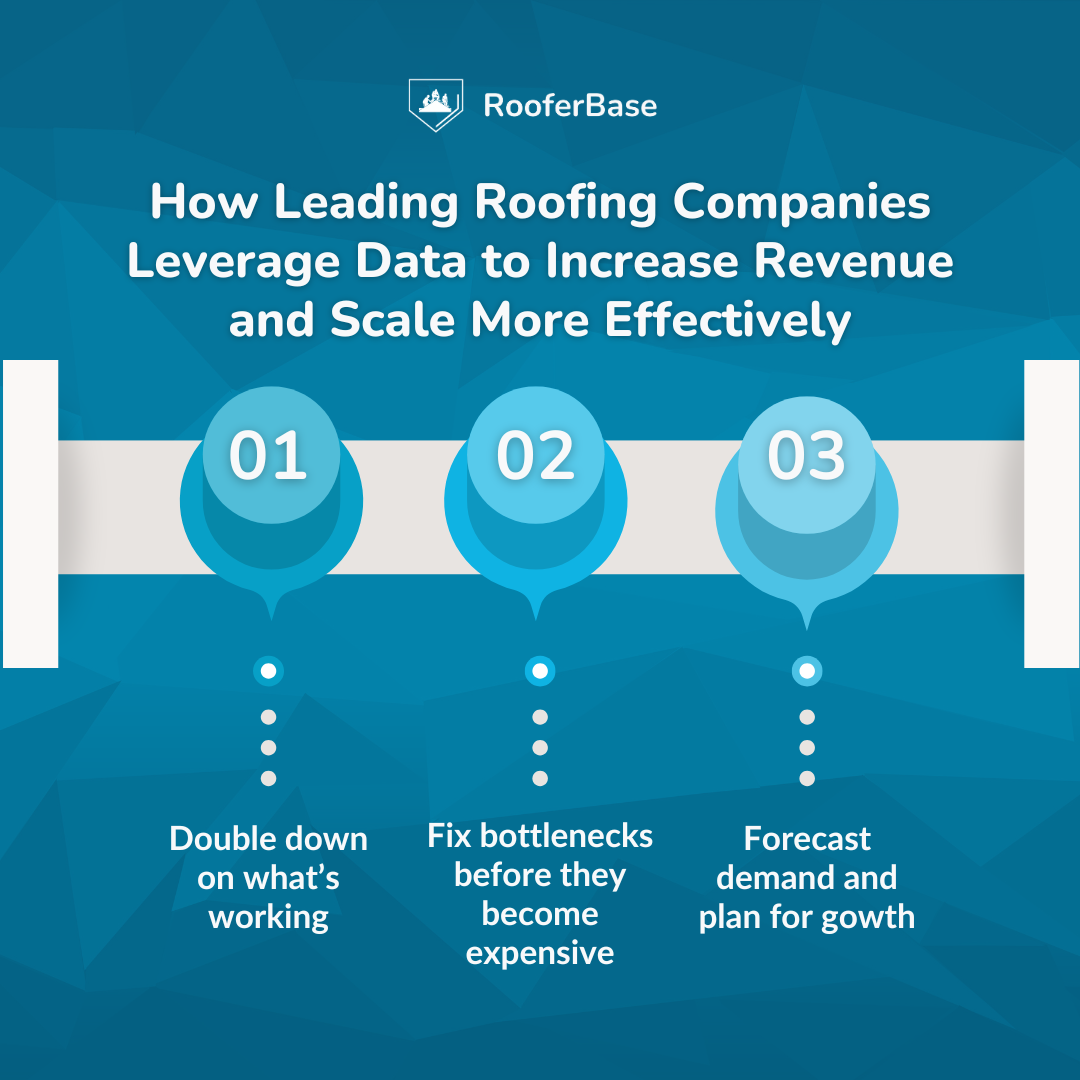
Top roofing companies don’t just gather data and leave it in a dashboard. They take action. Every metric, timeline, and lead, these insights turn into real decisions that boost revenue and grow operations without causing clutter.
Here’s how they do it (and how you can too):
1. Double Down on What’s Working
Understanding your customers’ journey is just the first step; then, focus on developing strategies to improve your marketing ROI. The key point is: Why invest in five marketing channels if only one is producing calls?
With data from your roofing software, you can:
- Spot high-ROI channels: Identify which channels or referrals are producing the best-quality leads and which may be wasting your budget.
- Focus on your star crews and zones: If Crew A completes jobs 30% faster and has fewer callbacks in Zone 2, why not assign them there more often?
2. Fix Bottlenecks Before They Become Expensive
If you’ve ever had to explain to a customer why their roof isn’t finished yet, you know how frustrating delays can be.
Roofing professionals can plan maintenance and replacements more effectively by simply using data-driven strategies.
Leading roofing contractors utilize timeline and issue tracking features within their software to:
- Identify where jobs are getting delayed (materials, permits, crew issues?)
- Set automatic alerts for tasks that exceed expected durations.
- Assign backup crews or escalate the problem before it gets out of control.
This is why companies resolving 85% of service calls on the first visit see fewer callbacks and less downtime.
3. Forecast Demand and Plan for Growth
Let's move to the time when the busy season begins.
Data-driven insights help roofing companies quickly respond to shifts in customer demands and seasonal trends. Many firms rely on industry data and historical metrics to set achievable goals, such as aiming for a 95% on-time project completion rate.
The top roofing companies rely on historical data to forecast demand, so they:
- Hire crews ahead of the upcoming flood of bookings.
- Order stock materials early to prevent price increases or backorders.
- Launch campaigns at the optimal time (before the rush begins)
And the best part? Roofing software can display patterns like:
- Seasonality (what months are busiest)
- Location demand (where most leads are coming from)
- Service popularity (what jobs get booked the most)
Mistakes to Avoid When Using Roofing Software Insights
Here's the thing: data is only useful if you're using it correctly. Let’s discuss the two most common mistakes that can secretly kill your momentum and how to avoid them.
> Tracking Too Many Vanity Metrics
Of course, it’s great to see how many people visited your homepage or opened your latest email. However, if that data doesn’t lead to increased sales or save you time, it’s useless.
Vanity metrics may seem impressive on a dashboard, but they don’t generate revenue.
Instead, focus on:
- Job profit margins: Are your jobs truly generating profit?
- Close Rates: Are your leads converting into deals?
- Crew Productivity: Who’s excelling, and who’s holding you back?
- Customer Lifetime Value (CLV) vs. Customer Acquisition Cost (CAC)
> Not Getting Team Buy-In
The reality is that most people resist adopting new tools because they are confused by the advanced features, worried that it will make their job more difficult, or just lazy about change.
So, what’s the solution?
Train them smart!
- Conduct brief walkthroughs instead of lengthy 90-minute sessions.
- Show how it simplifies their lives: less paperwork, faster scheduling, and quicker payment processing.
What makes Rooferbase the ultimate tool you need to grow your roofing business?
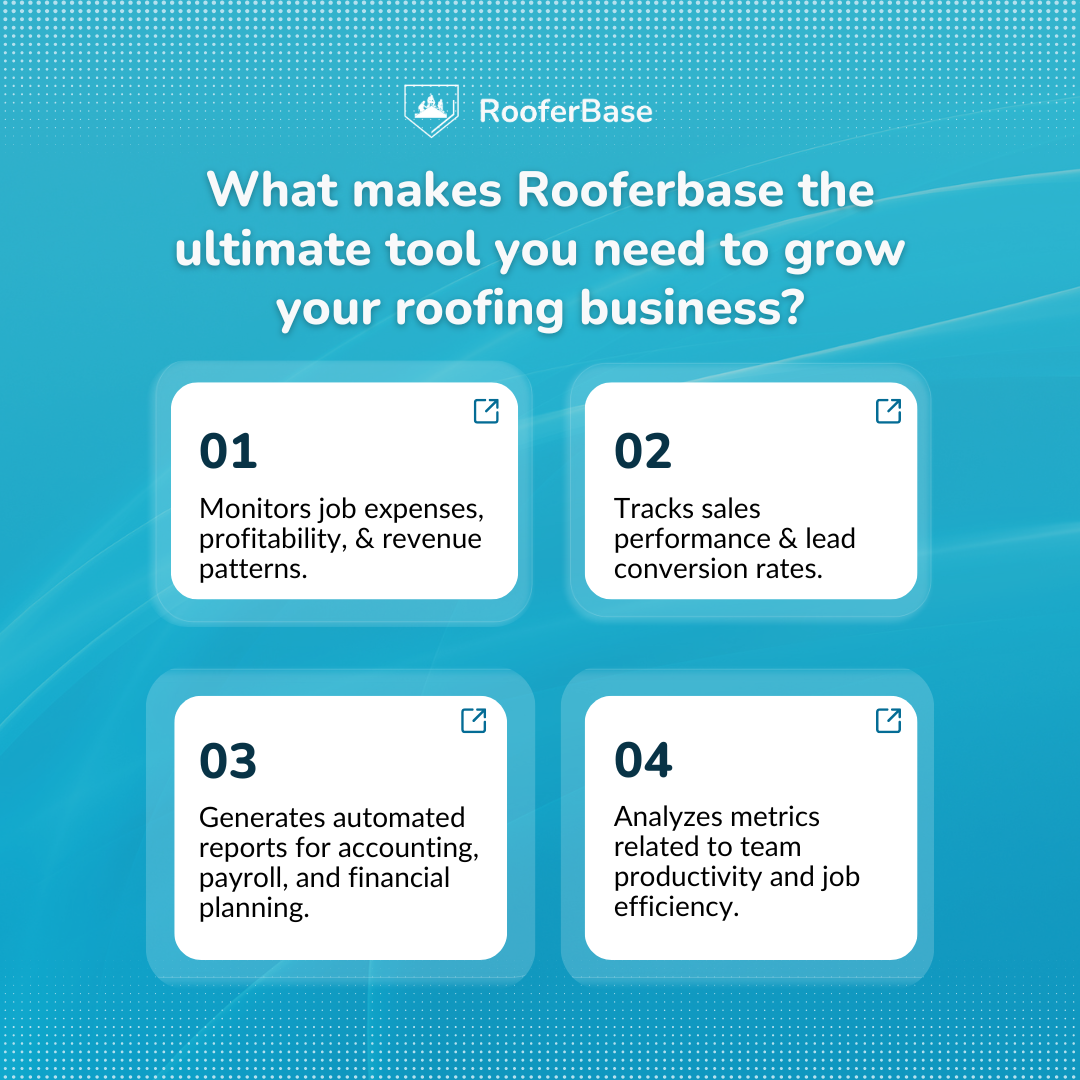
Amid rising energy costs, increasing customer expectations, and narrowing profit margins, the real edge comes from making data-driven decisions. That's where Rooferbase functions as your smart assistant.
> All the Tools in one place
With Rooferbase, you get all the tools in one single platform. From lead management and project management to payment processing and professional proposal templates, it empowers your sales team to track leads, build custom pricing, and send instant roof estimates with ease.
Want more repeat business? Better customer satisfaction? Stronger customer relationship management? Mission accomplished!
Rooferbase roofing CRM helps track leads, manage customer interactions, and improve your customer relationship management process.
Learn more about How a roofing CRM can revolutionize your business operations.
> Use Data That Actually Helps You Scale
Rooferbase isn’t just your generic CRM software; it’s a comprehensive business tools package that your team needs to streamline operations and grow on autopilot. So, what's more?
- Monitors job expenses, profitability, and revenue patterns.
- Tracks sales performance and lead conversion rates.
- Analyzes metrics related to team productivity and job efficiency.
- Generates automated reports for accounting, payroll, and financial planning.
It's time to make wiser moves with customizable dashboards, insights, and zero wasted resources. Just quality leads and real results!
In a nutshell
Your good instincts and guesswork might work today, but it's gonna cost you tomorrow.
Data helps you spot what’s working, fix what’s not, and grow faster without burning out your team (or your budget).
So, whether you’re aiming to improve the sales process, boost profits, or book more jobs, it all starts with smarter data.
Rooferbase: #1 All-in-One Tool for Roofing Contractors
Your next big win isn’t just luck; it’s in your numbers. With Rooferbase, you’ll finally get the clarity and confidence to make moves that matter.
Schedule your personalized demo and see how your numbers can start working for you!
FAQ’s
1. What is the profitability of an average roofing business?
The US roofing industry is valued at $52 billion, growing 11% from 2016 to 2026, adding about $5.72 billion annually. As housing demand continues to grow and the real estate market remains competitive, roofing companies can expect even more opportunities.
2. How can data actually help grow my roofing business? Isn’t roofing all hands-on work?
Data isn’t replacing your hands-on work; it’s enhancing it. Data helps identify profitable jobs, margins, and fast crews while reducing ad waste and focusing on quality leads. Think of it as your tool for boosting productivity, recording accurate roof measurements, and sealing more deals.
3. What makes Rooferbase different from other CRM systems out there?
Unlike generic CRM systems, Rooferbase is built just for roofers. From ordering roofing materials to generating fast and accurate roof measurements and proposals, it combines everything you need on one platform. You can oversee leads, plan jobs, monitor inventory, and enhance operational efficiency, all while upgrading your customer experience.


